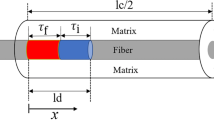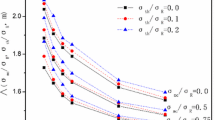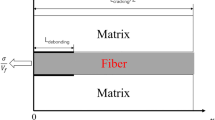Abstract
Damage in continuous-fiber reinforced metal-matrix composites can be quite complex because of the number of constituents (e.g., fiber, matrix or fiber/matrix interface) that can fail. Multidirectional lay-ups have an even greater number of possible damage orientations. Based on the simplifying assumption of equivalent constituent strain states in the absence of damage, a strain-based failure criterion may be applied to determine when and where initial damage will occur. Depending on the relative fatigue behavior of the fiber and matrix, as well as the interface properties, the failure modes can be grouped into four categories.
Similar content being viewed by others
References
W.S. Johnson, “Mechanisms of Fatigue Damage in Boron/Aluminum Composites,” Damage in Composite Materials, ASTM STP 775, K.L. Tfeifsnider, ed., American Society for Testing and Materials, Philadelphia (1982), pp. 83–102.
W.S. Johnson, C.A. Bigelow and Y.A. Bahei-El-Din, “Experimental and Analytical Investigation of the Fracture Processes of Boron/Aluminum Laminates Containing Notches,” NASA TP-2187, National Aeronautics and Space Administration, Washington, D.C. (1983), 43 pp.
W.S. Johnson, “Characterization of Fatigue of Fracture Damage Mechanisms in Continuous-fiber Reinforced Metal Matrix Composites,” Ph.D. Dissertation, Duke University, Durham, North Carolina (1979).
Y.A. Bahei-El-Din and G.J. Dvorak, “Plasticity Analysis of Laminated Composite Plates,” ASME Journal of Applied Mechanics,Vol. 49 (1982), pp. 740–746.
W.S. Johnson, “Modeling Stiffness Loss in Boron/Aluminum Laminates Below the Fatigue Limit,” Long-Term Behavior of Composites, ASTM STP 813, T.K. O’Brien, ed., American Society of Testing and Materials, Philadelphia (1983), pp. 160–176.
G.J. Dvorak and J.Q. Tarn, “Fatigue and Shakedown in Metal Matrix Composites,” Fatigue ofComposite Materials, ASTM STP 569, American Society for Testing and Materials, Philadelphia (1975), pp. 145–168.
G.J. Dvorak and W.S. Johnson, “Fatigue of Metal Matrix Composites,” International Journal of Fracture (16, 6) (1980), pp. 585–607.
W.S. Johnson and R.R. Wallis, “Fatigue Behavior of Continuous-fiber Silicon Carbide/Aluminum Composites,” Composite Materials: Fatigue and Fracture, ASTM STP 907, H.T. Hahn, ed., American Society for Testing and Materials, Philadelphia (1986), pp. 161–175.
W.S. Johnson, “Fatigue Testing and Damage Development in Continuous-fiber Reinforced Metal Matrix Composites,” Metal Matrix Composites: Testing, Analysis and Failure Modes, ASTM STP 1032, W.S. Johnson, ed., American Society for Testing and Materials, Philadelphia (1989).
W.S. Johnson, S.J. Lubowinski, A.L. Highsmith, W.D. Brewer and C.A. Hoogstraten, Mechanical Characterization of SCS6/Ti-15-3 Metal Matrix Composites at Room Temperature, NASP TM-1014 (1988), 44 pp.
D.M. Harmon, C.R. Saff and C.T. Sun, “Durability of Continuous-fiber Reinforced Metal Matrix Composites,” AFWAL TR-87-3060 (October 1987).
C.R. Saff and D.M. Harmon, “Stress and Strength Analysis of Metal Matrix Composites,” Metal Matrix Composites: Testing, Analysis, and Failure Modes, ASTM STP 1032, ASTM (1989).
K.N. Smith, P. Watson and T.H. Topper, “A Stress-Strain Function for the Fatigue of Metals,” Journal of Materials, ASTM (5, 4) (December 1970), pp. 767–778.
D.S. Mahulikar, Y.H. Park H.L. Marcus, “Environmental Influences on the Fracture and Fatigue Properties of Titanium Metal Matrix Continuous Fiber Composites,” Fracture Mechanics: Fourteenth Symposium—Volume II: Testing and Applications, ASTM STP 791 (1983), pp. 579–597.
G.C. Sih, Handbook of Stress Intensity Factors, Lehigh University, Bethlehem, Pennsylvania (1973).
Additional information
C.R. Saff received his master’s degree in engineering mechanics from the University of Missouri-Rolla in 1976. He is currently section chief in the Structural Research Division at McDonnell Aircraft Company.
D.M. Harmon received his master’s degree in structures and dynamics from George Washington University in 1985. He is currently an engineer in the Structural Research Division at McDonnell Aircraft Company.
W.S. Johnson received his Ph.D. in solid and structural mechanics from Duke University in 1979. He is currently senior research engineer at NASA Langley Research Center.
Rights and permissions
About this article
Cite this article
Saff, C.R., Harmon, D.M. & Johnson, W.S. Damage Initiation and Growth in Fiber-Reinforced MMCs. JOM 40, 58–63 (1988). https://doi.org/10.1007/BF03258813
Published:
Issue Date:
DOI: https://doi.org/10.1007/BF03258813




